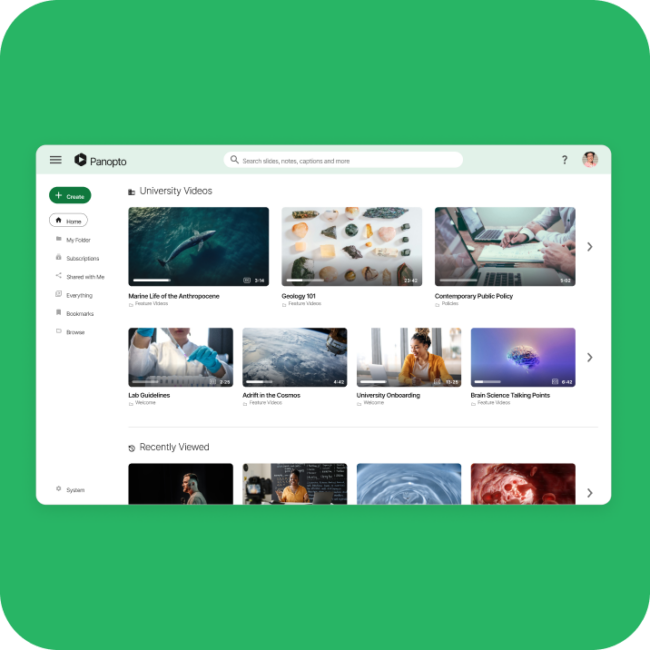- アカデミック・テクノロジー
学生の毎日の課題を動画で提出させる

太古の昔から、書くことは学問活動の主要な手段だったようです。 幼い頃から、生徒は理解を示し、議論をし、さらには自分自身のために新しい知識を生み出すために書くことを教えられます。 そして、それは理にかなっています。 書面によるコミュニケーションは簡単に生成でき、非常に移植性があります。 現在でも、数万語のテキスト文書に数十ページを簡単に録画し、電子メールで送信することができます。
 しかし、今日のビジネス界の慌ただしさの中で、「紙」はますます、まあ、平坦に感じられています。 書面によるコミュニケーション、特に電子メールは引き続き重要なコミュニケーションツールですが、プロフェッショナルは、同僚も顧客も長文のコンテンツを読みたがらないことにますます気づいています。
しかし、今日のビジネス界の慌ただしさの中で、「紙」はますます、まあ、平坦に感じられています。 書面によるコミュニケーション、特に電子メールは引き続き重要なコミュニケーションツールですが、プロフェッショナルは、同僚も顧客も長文のコンテンツを読みたがらないことにますます気づいています。
学校は、生徒が社会に出る準備をすることを使命としており、 生徒の実践的なコミュニケーションスキルを磨くための新しいより良い方法を考えています。
それに伴い、もうひとつの伝統的なコミュニケーションの形が、プレゼンテーションという新たな注目を集めています。 残念なことに、クラスのすべての学生にプレゼンテーションに十分な時間を与えるために必要な膨大な時間があるため、従来、クラス内でのプレゼンテーションは学期末の課題のために予約されていました。 結局のところ、リソースの縮小を補うためにクラスの規模が拡大している環境では、学生がクラスに追加されるたびに、それに応じて合計プレゼンテーション時間が長くなります。 15人のクラスのすべての生徒に10分しか話せないとすると、クラス内のプレゼンテーション課題1回に2時間半かかることになります。 その時点で、同僚からのフィードバックや質問の時間はいつあるのでしょうか?
参入障壁が急速に低下する中、動画は 学生のプレゼンテーションの問題を解決するための特効薬として浮上しています。 学生をグループに分け、クラス全員にすべてのプレゼンテーションを視聴させる必要をなくすことで、講師は動画を使用して、学生が教室の空き時間内にとどまりながら、仲間と自分の作品を発表し、復習する機会を与えることができます。
このアプローチにより、教室での時間の需要が少なくなるため、インストラクターはプレゼンテーションを定期的かつ価値のある課題にすることができます。
学生のビデオプレゼンテーションによるコミュニケーションスキルの指導
1.ビデオプレゼンテーションを成功させるために期待すること
どんな課題でもそうですが、最初の、そして最も重要なステップは、期待値を設定することです。 これは、課題の形式があまり馴染みのない場合に特に当てはまります。
プレゼンテーションを正しく行うために必要な数のテイクを記録することが適切で適切であることを生徒に保証します。 繰り返し行うことで、生徒は自信を持って話したり、プレゼンテーションをしたりすることができます。
また、与えられた課題で期待される「生産価値」のレベルについて、必ず学生と話してください。 明確で簡潔な配信に重点を置いた毎週のプレゼンテーションでは、生徒を机に座らせてウェブカメラに向かって話すのが適切な場合があります。 よりフォーマルなプレゼンテーションの場合、学生は自習室を使用し、フォーマルな対面プレゼンテーションと同じ服装をすることが期待される場合があります。
どのような方法を選択しても、期待値を設定することで、学生は当て推量を避け、自信を持つことができます。
2.録画した動画をアップロードできるようにする
ノートパソコンや携帯電話からの録画 動画がこれまでになく簡単になりました。 ほとんどのスマートフォンには、カメラと録画動画用のソフトウェアが内蔵されています。
もしあなたの学校がPanoptoのようなビデオ 講義キャプチャー ソリューションを使用しているなら、学生の録画をキャプチャーするために同じシステムを活用することも可能かもしれません。講義や プレゼンテーションを録画するソフトウェア は、一般的にYouTubeに録画するだけでなく、より多くの機能を提供します。特に、Panoptoのようなツールでは、PowerPointやKeynoteのプレゼンテーションを直接録画することができるので、学生はスライドをビデオに編集したり、スライドがカメラに映らないというリスクを冒す必要がありません。
生徒がプレゼンテーションを録画したら、講師や他の生徒がその動画にアクセスできるようにすることが重要です。ファイルは、Google Classroomのようなクラウドベースのファイル共有サービスにアップロードするか、Panoptoのような専用のビデオコンテンツ管理システム(ビデオCMS)にアップロードします。 ビデオCMSを使用すると、講師はすべてのビデオファイル を簡単に一元管理し、必要な人と共有することができるため、好ましいとされています。
いずれにせよ、必要なときにファイルを見つけ、共有し、保護できることが重要です。
学生プレゼンテーションは、学生に学んだことを実演してもらう効果的な方法です。 この外国語の授業の動画では、学生がスペイン語でメキシコ料理について短いプレゼンテーションをしています。
3. 授業時間外にプレゼンテーションを準備し、録音させる
さて、ここからが楽しいところです:学生はプレゼンテーションを準備し、記録します。 教室の貴重な時間をすべての生徒にクラスに出席させる代わりに、宿題としてプレゼンテーションを行うことで、生徒はプレゼンテーションを適切に行うためのほぼ無制限の時間を得ることができます。 プレゼンテーションが苦手な生徒は、録画を見直し、メッセージをよりよく伝えるための小さな調整を行う機会があります。
動画プレゼンテーションの課題に期待値を設定するときは、学生に期日を知らせてください。 他の学生は授業時間中にプレゼンテーションを確認する必要があるため、ジャストインタイム(授業前)にすることができますか、それとも授業の前に映像を収集して確認する時間が必要ですか?
4. 少人数のグループで授業を行い、仲間のプレゼンテーションを復習し、フィードバックを提供する
生徒が授業を受けるまでに、プレゼンテーションが完成し、クラスのWebサイトにアップロードされているはずです。
次に、生徒をクラスに適したサイズのグループに分けます。 少人数のグループでは、集中的な会話や個別の仲間からのフィードバックにより多くの時間を割くことができますが、大人数のグループでは、より多くのアイデアを生み出すことができます。
生徒は各動画を一緒に視聴し、コンテンツと配信の両方についてフィードバックを行いながら議論する必要があります。
また、プレゼンテーションの視聴は、生徒が自分のプレゼンテーションを準備し、他の人のプレゼンテーションをレビューするのに十分な時間が与えられている場合、授業前の宿題として割り当てることもできます。 このシナリオでは、生徒はクラスメートのプレゼンテーションを見たり、メモを取ったり、提供するフィードバックについて批判的に考え始めることができます。
教育向けの動画プラットフォームでは、 ビデオプレーヤー内のタイムスタンプ付きのメモ は、生徒が自分の考えを整理するのに役立ち、動画の作成者が別のフィードバックソースとして利用できるようにすることもできます。
5. 講師またはアシスタントがプレゼンテーションをレビューして評価する
プレゼンテーションの採点が重要な場合は、 のような一元的な 動画コンテンツ管理プラットフォームPanopto を使用すると、教員が評価プロセスを管理するのにも役立ちます。一般的な学習管理システムに統合 されているPanopto の安全な学生用ドロップボックスを使用することで、インストラクターは学生の動画に簡単にアクセスできるようにすることができます。
動画が動画コンテンツ管理システムにアップロードされると、教員とティーチングアシスタントは Panopto を使用して生徒の動画に注釈を付け、フィードバックを提供できます。
別のアプローチとして、インストラクターはさらに一歩進んで、自分のデスクから直接短い動画でフィードバックを録画することで、クラス内のプレゼンテーション形式を再現することもできます。 このようにして、生徒は仲間との集中的な議論だけでなく、教師からも恩恵を受けることができます。
学生に自信を持たせるために
![]() プレゼンテーションスキルはこれまで以上に重要であり、録画された動画を使用すると、インストラクターは学生に自信を持って話す機会を与えることができます。 学生のプレゼンテーションを通常の課題とし、定期的に仲間やインストラクターのフィードバックを受けることで、学生はより快適に感じるだけでなく、自分の進歩を批判的に評価することができます。
プレゼンテーションスキルはこれまで以上に重要であり、録画された動画を使用すると、インストラクターは学生に自信を持って話す機会を与えることができます。 学生のプレゼンテーションを通常の課題とし、定期的に仲間やインストラクターのフィードバックを受けることで、学生はより快適に感じるだけでなく、自分の進歩を批判的に評価することができます。
Panopto 大学で講師のプレゼンテーションを録画するところから始まり、今では世界中で毎週何万人もの学生や教授に利用されています。 Windows、Mac、iOS、Android端末にダウンロードできる録画ソフトを使えば、誰でもノートパソコンやスマートフォンから動画を録画し、 Panoptoの業界トップクラスの動画コンテンツ管理システムを使って、自動的に授業のWebサイトにアップロードすることができます。
Panopto が学生がより成功するプレゼンターになるのにどのように役立つかを確認するには、チームのメンバーに連絡して、今すぐ 無料トライアルをリクエスト してください。




